Should We Grow Orchid Plants in Water: A Beginners Guide
If you're considering growing orchids, you might wonder if water culture is a viable option for beginners. This method offers a simplified approach, reducing the risk of root rot and making it easier to monitor plant health. By mimicking their natural habitat, orchids can thrive with consistent moisture and transparent containers. But how do you shift your orchids to water culture, and what specific techniques will guarantee their success? Let's explore the steps and methods that can transform your plant care routine and potentially yield stunning results.
Benefits of Water Culture
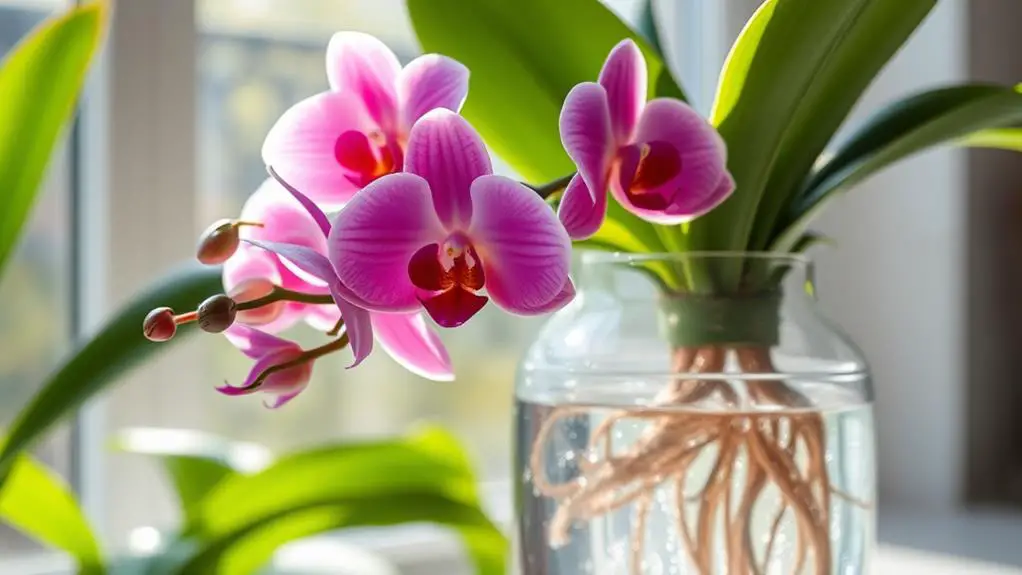
Water culture offers several compelling benefits for growing orchids. By using the water culture method, you can effectively resolve issues with soggy potting media, which is often a major cause of root rot. Orchids in water will thrive without this risk, as they get consistent moisture to their aerial roots, mimicking their natural habitat.
This method is also low maintenance, making it easier for you to care for your plants.
One major advantage is the ability to monitor root health easily. Transparent containers let you visually assess the condition and growth of the roots, so you can address any issues promptly. This is especially helpful for beginners who want to understand their orchid needs better.
Additionally, water culture tends to have fewer pest problems. Fewer pests like fungus gnats are present because there's less organic matter compared to traditional potting media.
If you have an ailing orchid, the water culture method can greatly improve its health. Proper water management can revitalize struggling plants, giving them a new lease on life.
Choosing the Right Orchid
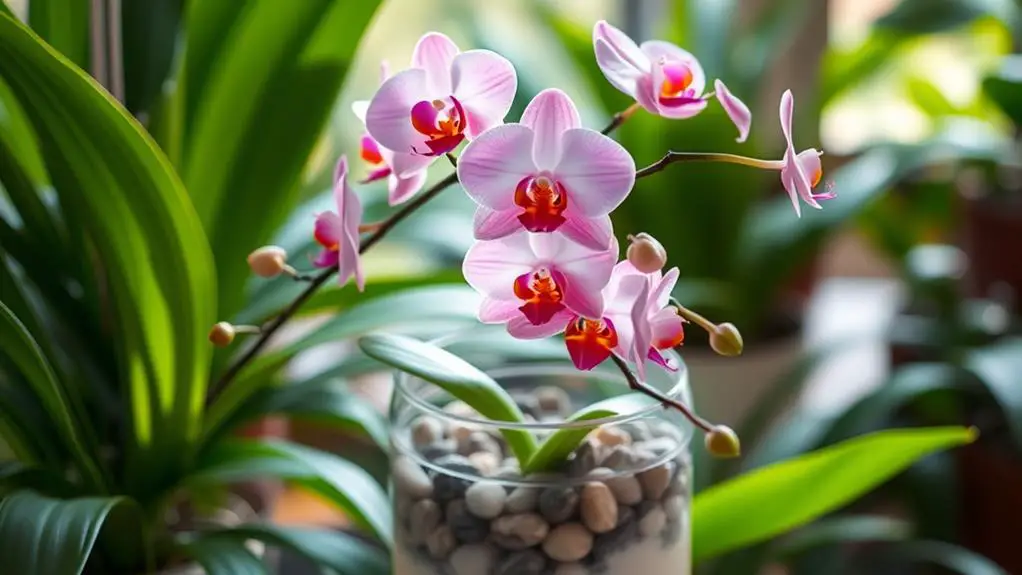
With the benefits of water culture in mind, choosing the right orchid becomes your next significant step. For novice growers, phalaenopsis orchids are an excellent choice. They're adaptable and forgiving, making them perfect for water culture.
When you're selecting your orchid, keep these tips in mind:
- Choose fairly new plants. Established orchids might struggle with the change in growing environment.
- Inspect the roots. Healthy roots should be firm and light-colored. Avoid orchids with browning or mushy roots, as these are signs of poor health or rot.
- Local grocers and home improvement stores usually carry a variety of orchids, making them accessible and convenient.
- Be patient. Even if challenges arise, you can successfully grow orchids in water with careful observation and adjustment.
- Trust your instincts. If a plant looks vibrant and healthy, it's likely a good candidate for water culture.
Phalaenopsis orchids thrive in water culture, especially for beginners. Healthy roots are essential, so take your time inspecting potential plants.
With patience and the right selection, you'll enjoy the beauty and simplicity of growing orchids in water. Remember, success is achievable with a bit of care and attention.
Preparing Your Orchid

To get your orchid ready for water culture, you'll start by carefully un-potting it and removing all the potting media. This includes getting rid of any moss or bark around the roots. It's important to do this gently to avoid damaging the roots.
After you've removed all the potting media, rinse the roots thoroughly under running water. This step helps eliminate any debris and gives your orchid a clean start.
Next, inspect the roots closely. You'll want to cut away any sections that are discolored or rotten. Healthy roots are essential for your orchid to thrive in water culture.
Once you've pruned away the bad parts, allow the roots to dry for 1-2 days. This drying period helps prevent shock and encourages healthy root development.
When choosing a container, use a transparent one. It allows you to easily monitor the health and growth of the roots.
Keep the crown elevated by adding clay pebbles for support. This guarantees the plant stays stable and doesn't sit in water, which can cause rot.
Water Culture Methods
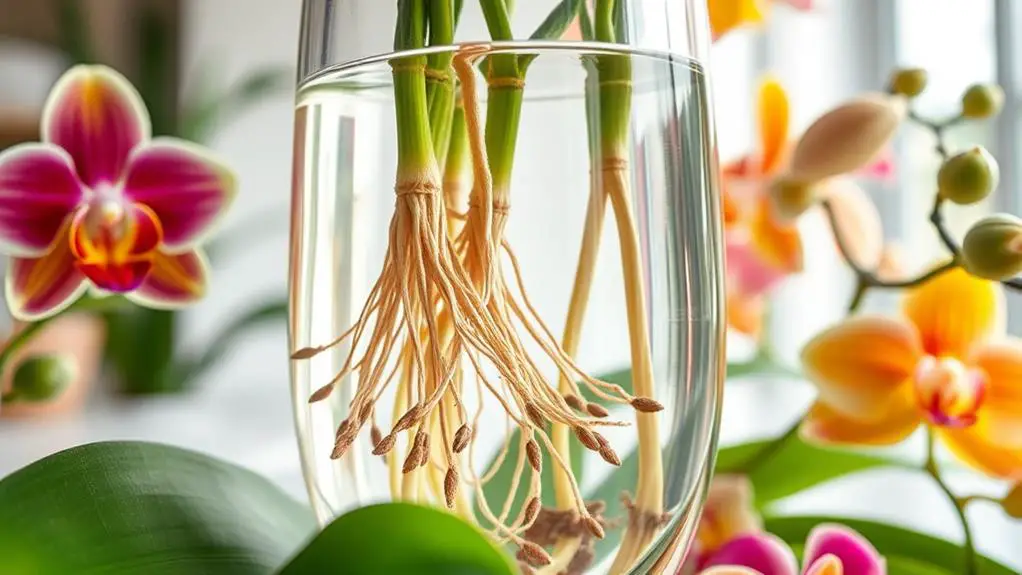
Let's talk about water culture methods for growing your orchids.
Full water culture means keeping 1/3 to 2/3 of the roots submerged in water for 4-5 days a week, while semi-water culture involves alternating between 2-3 days in water and 4-5 days dry to mimic natural conditions.
Remember to monitor root health closely; silverfish roots mean it's time to water.
Full Water Culture
Full water culture, an increasingly popular method for orchid enthusiasts, involves submerging about 1/3 to 2/3 of the orchid's roots in water. This technique helps orchids absorb moisture and nutrients directly from their environment, making it simpler to care for them.
To get started, you'll want to make certain you maintain the water level consistently. Here are some tips to guarantee success:
- Change the water weekly: Retain 20%-50% of the original water to provide continuity for the plant.
- Monitor root color: Orchid roots turn a silverfish hue when they need water.
- Allow breathing time: Keep the plant submerged for 4-5 days a week, then let it dry for one day to prevent root rot.
- Check root health regularly: Watch for any signs of root rot, which can occur if roots are submerged too long.
- Nutrients from the air: Orchids still need some exposure to air for nutrients, so don't submerge them completely.
Maintaining the water level is essential. Too much water can lead to root rot, while too little can dry them out.
Semi-Water Culture
Shifting to semi-water culture can really make a difference in the health of your orchid plants. In this method, you submerge about two-thirds of the orchid's roots in water and let the plant dry out for 4-5 days between soaking sessions. This mimics the orchid's natural environment, promoting healthy root growth by alternating between moist and dry conditions, which helps prevent root rot.
Water regularly, but guarantee you change it while retaining 20%-50% of the original water. This keeps beneficial bacteria and nutrients that your orchids need. Watch for the roots to turn silverfish; it's a visual cue that it's time to adjust water levels.
Here's a handy table to summarize the semi-water culture process:
| Step | Description |
|---|---|
| Submerge Roots | Submerge 2/3 of roots in water |
| Dry Out Period | Allow 4-5 days of drying out between soaking |
| Water Change | Change water regularly, keep 20%-50% of old water |
Regular observation is key. Adjust based on your plant's health, as some orchids may prefer different wet/dry ratios. High humidity around the plant also helps in maintaining moisture and nutrients, guaranteeing your orchid thrives in its semi-water culture setting.
Root Health Monitoring
Monitoring the health of your orchid's roots is essential for successful water culture methods. You'll need to check the color and condition of the roots regularly. Healthy roots are usually green or silvery, while brown or mushy roots can signal rot or distress.
Here are some practical tips to help you:
- Check the water levels closely. Submersion should be between 1/3 to 2/3 of the roots, depending on your chosen water culture method.
- Change the water weekly or bi-weekly. Always retain 20%-50% of the original water to keep beneficial bacteria and nutrients.
- Use a transparent container to easily observe root health. This makes it simpler to detect any algae or bacterial growth.
- Remove dead or discolored roots immediately. This prevents them from harming the overall health of your orchid and encourages new growth.
- Look for signs of distress such as brown or mushy roots and act quickly to address any issues.
Submersion Duration
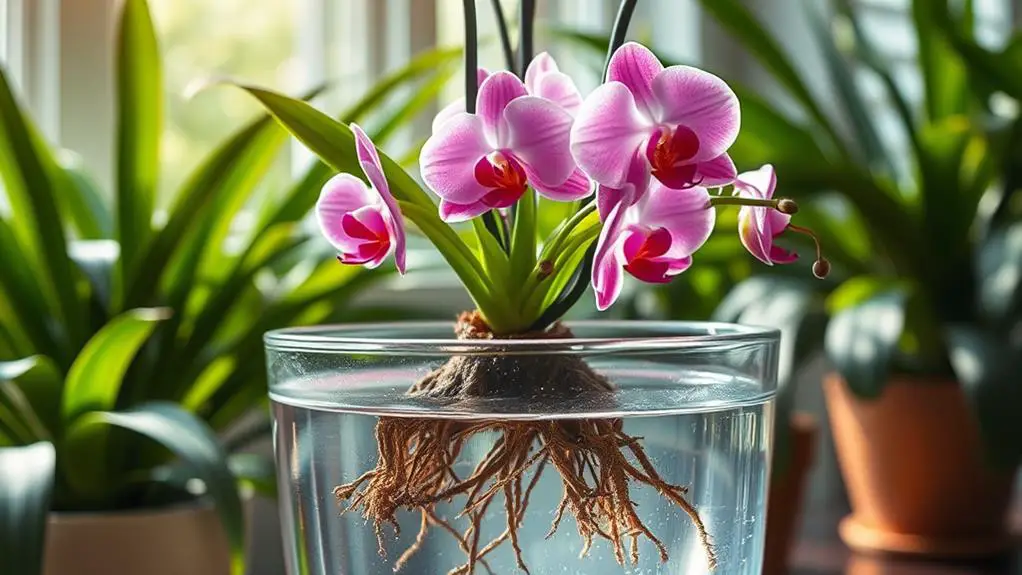
When growing orchids in water, you can choose between two main methods: constant submersion or a rotational soaking schedule.
Some growers keep their orchids submerged all the time, changing the water weekly, while others prefer to soak them for two days and let them dry for five.
It's essential to watch for signs of distress like wilting or discoloration, which might mean you need to adjust the submersion duration.
Constant Submersion Method
The constant submersion method involves keeping your orchids submerged in water for extended periods, typically up to a week. This technique can promote healthy growth by guaranteeing the root system stays moist, which many orchid growers find beneficial. However, it's vital to follow some guidelines to guarantee your orchids thrive.
- Water changes: Change the water weekly to prevent stagnation and keep it fresh.
- Root submersion: Submerge only 1/3 to 2/3 of the roots, leaving the crown above water to avoid rot.
- Root monitoring: Check the root color regularly; green roots indicate good moisture, while silvery roots need more water.
- Health check: If your orchid's health declines, adjust the duration of submersion or switch methods.
- Nutrient uptake: Consistent moisture can help struggling orchids by improving nutrient absorption.
Regular monitoring is key. Guarantee the roots stay green and healthy, signaling proper hydration.
If you notice the roots turning silvery or the plant showing signs of distress, you might need to tweak your approach.
The constant submersion method can be a game-changer for your orchids, as long as you pay attention to their needs and make adjustments as required.
Rotational Soaking Schedule
A widely recommended rotational soaking schedule for growing orchids in water involves submerging the roots for two days, then allowing them to dry for five days. This method mimics the orchid's natural wet and dry cycles, promoting healthy growth.
To start, place your orchid's roots submerged in water for 48 hours. After that, let them dry out for the next five days. This cycle helps prevent root rot and encourages the plant to thrive.
Monitoring is key. Keep an eye on your orchid's roots. If they turn a silvery color, it's a sign they need water. On the other hand, if you notice wilting or discoloration, it might mean you need to adjust the soaking schedule. Some orchids might require shorter or longer durations based on their individual needs.
Water culture can be a bit of a balancing act, but with careful observation, you'll find the right routine. Remember, successful growth in water culture depends on fine-tuning the wet/dry cycles to suit your plant.
Don't be afraid to make adjustments and trust your instincts. With patience and care, your orchids will flourish.
Fertilizing Orchids
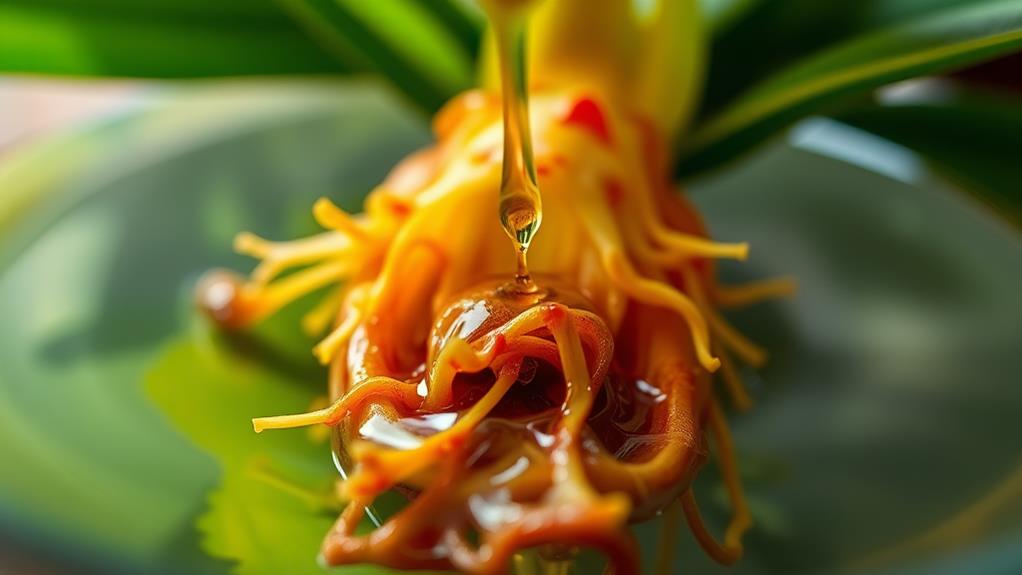
To keep your water-grown orchids thriving, fertilizing correctly is essential. You want your orchids growing strong and healthy, and the right fertilizer will help achieve that.
Ideally, you should fertilize during water changes, using a specialized orchid fertilizer diluted to 25% strength. This prevents root burn and maintains a good nutrient balance.
Here are some practical tips:
- Fertilize during water changes: This is the best time to add nutrients without overwhelming the plant.
- Dilute to 25% strength: Orchids are sensitive, so a weaker solution avoids root burn.
- Use kelp once a month: For non-reblooming orchids, kelp promotes overall health and growth.
- Change water regularly: Every one to two weeks is ideal to maintain nutrient balance and avoid harmful bacteria.
- Observe plant response: Adjust fertilization based on how your orchids react. Look for signs like yellowing leaves or wilting.
Common Challenges
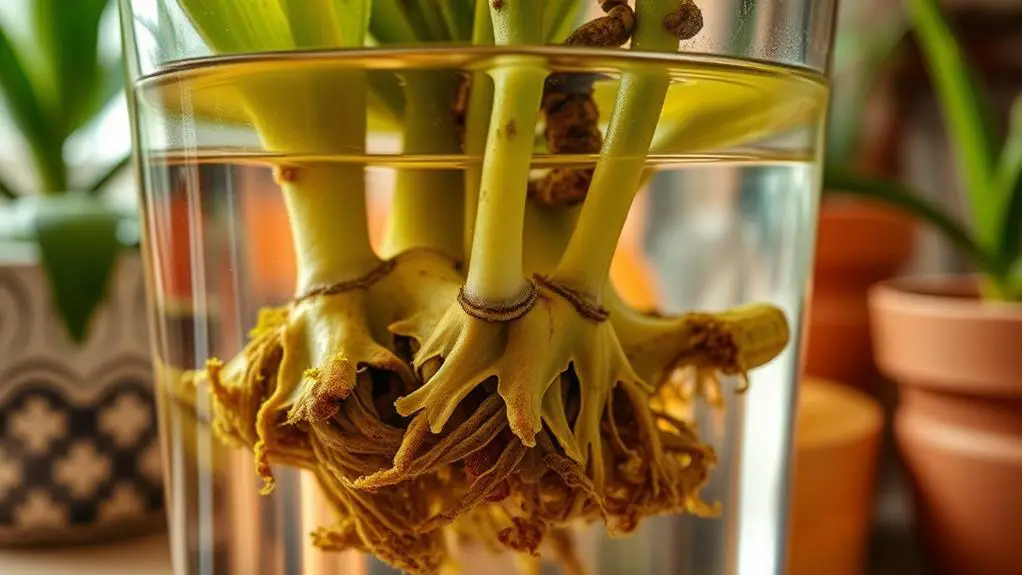
Growing orchids in water presents unique challenges that can test even the most experienced gardeners. One common issue is overwatering, which can lead to root rot. To avoid this, you'll need to monitor water levels and change the water frequently. It's a delicate balance, but with practice, you'll get the hang of it.
Water quality is another critical factor. Tap water often contains chlorine or high mineral levels that can harm your orchids. Instead, try using rainwater or distilled water to keep your plants healthy. If you notice yellowing leaves, it might be a sign of poor water quality or nutrient deficiencies.
Transitioning orchids from traditional potting to water culture can also stress the plants. To prevent shock, acclimatize them gradually. Start by dipping the roots in water for a few hours a day, then slowly increase the time.
Fertilizing in water culture requires special attention. Orchids may need more nutrients than usual. Be careful not to over-fertilize, as this can cause problems. If you see yellowing leaves or other signs of distress, it's a signal to adjust your care routine.
With patience and careful observation, you can overcome these challenges and enjoy beautiful, thriving orchids.
Monitoring Plant Health

Keeping a close eye on your orchids is vital for maintaining their health, especially when growing them in water. Regularly inspecting your orchid roots is important. Look for signs of distress, such as discoloration or wilting. Healthy roots should be green or silverfish. If they turn brown or mushy, it's a sign of root rot and requires immediate attention.
Monitoring plant health also involves keeping an eye on water quality. Change the water every one to two weeks to prevent harmful bacteria and algae growth. Poor water quality can hurt your orchid's health.
Observing the leaves is another key aspect. Yellowing leaves may indicate overwatering or nutrient deficiencies, while wilting leaves often signal underwatering. Adjust your watering schedule based on your orchid's response. For instance, if the roots appear dry or turn silverfish, consider a soaking schedule to guarantee adequate moisture.
Here are some quick tips to help you:
- Inspect roots for color and texture regularly.
- Change the water every one to two weeks.
- Watch for yellowing leaves as a sign of overwatering.
- Look out for wilting leaves to avoid underwatering.
- Adjust your watering schedule based on root appearance.
Community Insights

Engaging with fellow orchid enthusiasts, both online and locally, can greatly enhance your orchid-growing journey. Connecting with community forums and local orchid growers provides you with valuable insights and tips.
These platforms are rich with personal experiences and advice, especially when it comes to Phalaenopsis and water culture methods. You'll find that many seasoned growers suggest starting with Phalaenopsis because they're less sensitive and more forgiving, increasing your chances of success.
Participating in community forums allows you to learn from others' challenges and triumphs. You can troubleshoot common issues and avoid mistakes that others have made.
These forums are full of detailed discussions about orchid care, from watering schedules to dealing with pests. It's like having a group of mentors available anytime you need them.
Local orchid societies are also a fantastic resource. They often host workshops, seminars, and other events where you can learn hands-on techniques and ask questions in real-time.
Sharing your successes and failures with these communities fosters a supportive environment, encouraging you to experiment and learn.
Frequently Asked Questions
How Long Should I Leave My Orchid in Water?
You should leave your orchid in water for either a constant submersion with weekly water changes or a schedule of 2 days in water followed by 5 days of drying. Adjust based on your plant's health and root color.
How to Grow Orchids for Beginners?
To grow orchids for beginners, start by picking adaptable species like Phalaenopsis. Remove potting media, rinse and trim roots, and use a transparent container. Change water weekly, add diluted fertilizer, and monitor root and leaf health.
Should I Mist or Water Orchids?
You should mist orchids to maintain humidity but don't replace regular watering. Water them when the potting medium feels slightly dry. Use distilled or rainwater, and mist early in the day. Avoid waterlogged roots to prevent rot.
How to Revive Orchids in Water?
To revive orchids in water, unpot them, remove old media, and rinse roots. Trim dead roots, let them dry, then submerge 1/3 to 2/3 in water. Follow a soak/dry schedule, change water weekly, and fertilize.
Conclusion
Growing orchids in water can be a fun and rewarding experience. You'll enjoy seeing your plants thrive with consistent care. Remember to choose healthy orchids, shift them carefully, and keep an eye on their roots. Regular water changes and proper fertilization are key. Don't worry if you face challenges; it's all part of learning. With patience and attention, your orchids will flourish, and you'll feel proud of your green thumb. Happy gardening!







